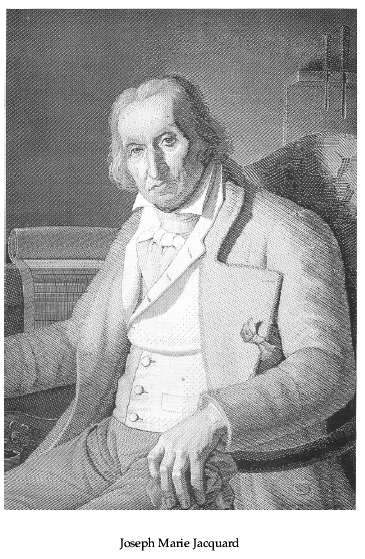History of Computers - Joseph Jacquard

Brian White
Joseph-Marie Jacquard was a French man born to a family of weavers on July 7, 1752, in Lyon and died on August 7 1834 in Oullins. He inherited his family's business when they died. When working as a draw boy, a job in which a person would sit inside of the loom and move threads according to how the master weaver commanded, he discovered that the job of weaving was tedious and unpleasant. Also, weavers could not make much money because the work put into textiles heavily outweighed the profits. Jacquard decided to create a programmable machine that would allow for faster and easier creation of textiles.
Contents
Overview
Joseph-Marie Jacquard completed his automatic loom in 1801 and presented in Paris in 1804, where Napoleon Bonaparte advanced means to continue Jacquard's experiments; for his invention he received a medal and a patent. Jacquard sold the rights to his loom, making it public property. Jacquard's loom worked by using a series of hooks with needles and wooden cards. The cards were thick and had rectangular holes in them. When the hooks and needles came in contact with the card, they would remain stationary. Hooks would eventually encounter holes and fall into the holes, while the needle inserted another thread. The arrangement of the holes would create different patterns, and the cards could be re-used to create the same pattern over and over again. Master weavers despised Jacquard's invention because it made them obsolete, as they could not produce identical patterns or do it as fast. Jacquard's invention made the weaving process easier and cheaper.
![]()
Significance
The programmable loom's punch cards were the first form of ROM (read only memory), memory in the form of holes on the card that could be used to create the same pattern over and over again. The punch cards were revolutionary because they were the first creation that allowed a machine to follow an algorithm. Jacquard's punch cards helped spark the computer revolution, and the idea of punch cards was used by many computer scientists in the future, including Charles Babbage and his Analytical Engine, which used the punch cards to do mathematical equations.
References
http://library.thinkquest.org/C0126120/jacquard.htm
http://www.ideafinder.com/history/inventions/jacquard.htm
http://www.makingthemodernworld.org.uk/icons_of_invention/technology/1820-1880/IC.031/
http://www.spartacus.schoolnet.co.uk/SCjacquard.htm
http://www.sacklunch.net/biography/J/JosephMarieJacquard_1.html
http://www.cs.arizona.edu/patterns/weaving/illustrations.html